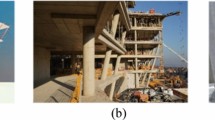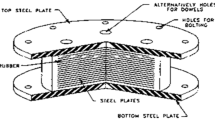Abstract
Modulus reduction and damping ratio variation with small shear strain amplitudes that are important in dynamic calculations are measured by a resonant column apparatus. These curves are made up of shear modulus, damping ratio and shear strain amplitude at which the shear modulus and damping ratio are measured. There is research into the reliability of the shear modulus and damping ratio measured by the apparatus, but the reliability of shear strain measurement has not been explored. The research questions herein are the reliability of shear strain measurements and the cause of probable deviations. Shear strain amplitudes in the apparatus are measured by its motion transducers. We used additional local strain gauges fixed to dummy specimens to double-check the shear strain amplitude measurements and answer the above questions. The obtained results include satisfying similarity in medium ranges of frequency and shaking amplitudes. However, the key finding is that deviation in the measurement results beyond the above-mentioned frequencies indicates that reliability of shear strain amplitudes in resonant column tests is of major concern; deviation of shear strain amplitudes can affect the interpreted soil properties and the results of the calculations based on these properties. The probable reasons for such differences between measurements of the strain gauge with those of the resonant column accelerometer are mentioned in the paper for further research. The novelty of the study is that it shows the necessity of a more thorough investigation on the measuring method and interpretation of the vibration amplitude in resonant column apparatuses.










Similar content being viewed by others
Data availability
Enquiries about data availability should be directed to the authors.
References
Ashlock JC, Drnevich VP, Pak RY (2013) Strain measures for transfer function approaches to resonant column testing. Geotech Testing J 36(4):455–465
Ashmawy AK, Drnevich VP (1994) A general dynamic model for the resonant column/quasi-static torsional shear apparatus. Geotech Testing J 17(3):337–348
ASTM D4015 (2021) Standard Test Methods for Modulus and Damping of Soils by Fixed-Base Resonant Column Devices, ASTM International, West Conshohocken, PA, www.astm.org
ASTM D3740-19 (2019) Standard Practice for Minimum Requirements for Agencies Engaged in Testing and/or Inspection of Soil and Rock as Used in Engineering Design and Construction, ASTM International, West Conshohocken, PA, www.astm.org
ASTM D8295-19 (2019) Standard Test Method for Determination of Shear Wave Velocity and Initial Shear Modulus in Soil Specimens using Bender Elements, ASTM International, West Conshohocken, PA, www.astm.org
Brüel and Kjær, Piezoelectric Accelerometer Product Data, Charge Accelerometer. Type 4371, 4371 S and 4371V, Brüel and Kjær, Denmark, www.bksv.com
Clayton CRI, Priest JA, Bui M, Zervos A, Kim SG (2009) The Stokoe resonant column apparatus: effects of stiffness, mass and specimen fixity. Geotechnique 59(5):429–437
De Silva LI, Koseki J, Sato T, Wang L (2006) High capacity hollow cylinder apparatus with local strain measurements. Geomechanics II: Testing, Modeling, and Simulation, Kyoto, Japan
Drnevich V P, Hardin B O, Shippy D J (1978) Modulus and damping of soils by the resonant-column method pp 91–125. ASTM International, West Conshohocken, PA, www.astm.org
Drnevich VP, Werden S, Ashlock JC, Hall JR (2014) Applications of the new approach to resonant column testing. Geotech Test J 38(1):23–39
Facciorusso F, Madiai C (2020) On cohesive soil damping estimation by free vibration method in resonant column test. Geotech Test J 43(6):1499–1518. https://doi.org/10.1520/GTJ20180241
Goto S, Tatsuoka F, Shibuya S, Kim Y, Sato T (1991) A simple gauge for local small strain measurements in the laboratory. Soils Found 31(1):169–180
Hardin B, Music J (1965) Apparatus for vibration of soil specimens during the triaxial test. Instruments and Apparatus for Soil and Rock Mechanics. ASTM STP 392:55–74
He H, Senetakis K (2016) A study of wave velocities and Poisson ratio of recycled concrete aggregate. Soils Found 56(4):593–607
Ishihara K (1996) Soil behaviour in earthquake geotechnics. Clarendon Press, Oxford
Karray M, Abdellaziz M, Lashin I (2022) Effect of the driving system on Hardin-type resonant columns. Can Geotech J 59(9):1685–1689
Kawaguchi T, Ogino T, Yamashita S, Kawajiri S (2016) Identification method for travel time based on the time domain technique in bender element tests on sandy and clayey soils. Soils Found 56(5):937–946
Kenkyujo TS (2011) TML precise and flexible strain gauges. Tokyo Sokki Kenkyujo Co, Tokyo
Lee JS, Santamarina JC (2005) Bender elements: performance and signal interpretation. J Geotech Geoenviron Eng 131(9):1063–1070
Lenart S, Koseki J, Miyashita Y, Sato T (2014) Large-scale triaxial tests of dense gravel material at low confining pressures. Soils Found 54(1):45–55
Leong EC, Cahyadi J, Rahardjo H (2009) Measuring shear and compression wave velocities of soil using bender–extender elements. Can Geotech J 46(7):792–812
Leong EC, Cheng ZY (2018) Timoshenko beam effect in flexural resonant column tests. Soils Found 59(1):234–239
Leong EC, Yeo SH, Rahardjo H (2005) Measuring shear wave velocity using bender elements. Geotech Testing J 28(5):488–498
Li H, He H, Senetakis K (2018) Calibration exercise of a Hardin-type resonant column. Géotechnique 68(2):171–176
Madhusudhan BN, Senetakis K (2016) Evaluating use of resonant column in flexural mode for dynamic characterization of Bangalore sand. Soils Found 56(3):574–580
Mortezaie A, Vucetic M (2016) Threshold shear strains for cyclic degradation and cyclic pore water pressure generation in two clays. J Geotech Geoenviron Eng 142(5):04016007
Picornell M, Nazarian S, Almadhoun AY (2013) Effect of specimen coupling on the torsional resonant column test. Geotech Testing J 36(4):476–483
Sabogal KG, Getchell A, Santagata M, Drnevich VP (2023) Resonant column calibration and dynamic torsional shear testing using stepped frequency sweeps. Geotech Testing J 46(2):379–402
Seiken (1998) Technical documentation of combined dynamic triaxial and resonant column test apparatus, Seiken Inc., Tokyo
Semblat JF, Pecker A (2009) Waves and vibrations in soils: earthquake, traffic, shocks, construction works. IUSS Press, Pavia
Shinde NS, Kumar J (2021) Effect of slenderness ratio of the specimen on resonant column test results. J Test Eval 49(6):4040–4057. https://doi.org/10.1520/JTE20200177
Srokosz PE, Dyka I, Bujko M, Bocheńska M (2021) A modified resonant column device for in-depth analysis of vibration in cohesive and cohesionless soils. Energies 14(20):6647
Tallavo F, Cascante G, Sadhu A, Pandey MD (2013) New analysis methodology for dynamic soil characterization using free-decay response in resonant-column testing. J Geotech Geoenviron Eng 140(1):121–132
Vrettos C, Banzibaganye G (2022) Effects of specimen size and inertia on resonant column tests applied to sands. Soil Dyn Earthquake Eng 155:107136
Werden SK, Drnevich VP, Hall JR, Hankour C, Conlee CT, Marr WA (2013) New approach to resonant column testing. Geotech Testing J 36(2):169–177
Yimsiri S, Soga K, Chandler SG (2005) Cantilever-type local deformation transducer for local axial strain measurement in triaxial test. Geotech Testing J 28(5):445–451
Acknowledgements
This study was supported partly by the International Institute of Earthquake Engineering and Seismology (IIEES) as technical project No.6140 and partly by the Iran National Science Foundation (INSF) as research project No.93038030. The author gratefully acknowledges the IIEES and INSF and extends special thanks Mr. M. Asgari, Mr. G. Hadavi and Mr. S. Azadmanesh for their assistance in conducting the tests. Mr. M. Jabbarzade and Mr. E. Tayury are also highly acknowledged for their valuable help and support.
Funding
This study was supported partly by the International Institute of Earthquake Engineering and Seismology (IIEES) as technical project No.6140 and partly by the Iran National Science Foundation (INSF) as research project No.93038030.
Author information
Authors and Affiliations
Corresponding author
Ethics declarations
Conflict of interest
The authors declare that they have no conflict of interest.
Additional information
Publisher's Note
Springer Nature remains neutral with regard to jurisdictional claims in published maps and institutional affiliations.
Rights and permissions
Springer Nature or its licensor (e.g. a society or other partner) holds exclusive rights to this article under a publishing agreement with the author(s) or other rightsholder(s); author self-archiving of the accepted manuscript version of this article is solely governed by the terms of such publishing agreement and applicable law.
About this article
Cite this article
Jalili, J. Investigation on Measurement of Vibration Amplitude by Torsional Resonant Column Apparatus. Geotech Geol Eng 41, 4677–4689 (2023). https://doi.org/10.1007/s10706-023-02539-w
Received:
Accepted:
Published:
Issue Date:
DOI: https://doi.org/10.1007/s10706-023-02539-w




